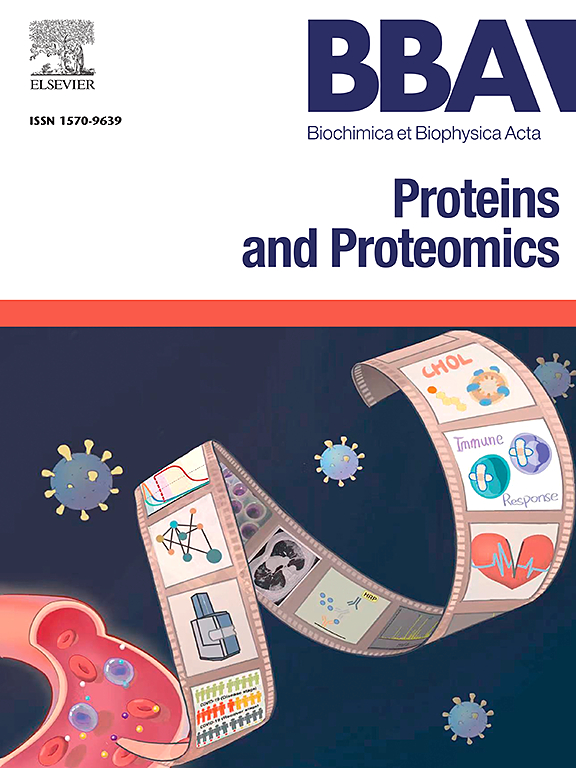针对人类脂蛋白 B-100 生成的新型单克隆抗体的 CDR 识别、表位图绘制和结合亲和力测定。
IF 2.3
4区 生物学
Q3 BIOCHEMISTRY & MOLECULAR BIOLOGY
Biochimica et biophysica acta. Proteins and proteomics
Pub Date : 2024-10-23
DOI:10.1016/j.bbapap.2024.141058
引用次数: 0
摘要
对内部生成的载脂蛋白 B-100(apoB-100)克隆 hLDL-E8、hLDL-2D8 和 hLDL-F5 mAbs 进行了广泛研究,以确定它们的互补决定区(CDR)、结合表位和亲和力。RT-PCR 显示,所有 mAbs 都由 kappa 轻链和 gamma 重链组成。DNA 测序和生物信息学分析表明,其 CDR 的可变基因和蛋白质序列与现有数据库的一致性超过 50%。利用 SWISS-MODEL 平台构建了 QSQE 分数高于 0.7 的 mAb 可变片段(Fv)的三维结构。拉马钱德兰图证实了结构的准确性,99% 的氨基酸残基位于可接受的区域内。apoB-100的溶栓裂解和Western印迹分析表明,hLDL-E8和hLDL-F5与T3片段(aa 1297-3249)特异性结合,而hLDL-2D8则与T4片段(aa 1-1297)结合。利用抑制酶联免疫吸附法进行的表位结合试验证实了这些发现,结果表明 hLDL-E8 与 hLDL-2D8 结合的表位不同,与 hLDL-F5 有一些重叠。最后,通过间接 ELISA 检测了 mAbs 的结合亲和力。mAbs hLDL-2D8、hLDL-E8 和 hLDL-F5 的平均亲和力常数(Kaff)分别为 1.51 ± 0.69 × 109 Mol-1、7.25 ± 3.56 × 108 Mol-1 和 4.39 ± 2.63 × 106 Mol-1。此外,抗体在剂量-反应曲线中的表现显示,hLDL-F5 可能识别载脂蛋白 100 的两个表位或具有极低的结合亲和力。相比之下,hLDL-2D8 和 hLDL-E8 只能识别一个表位。这些发现为实验室和临床研究人员选择 mAbs 提供了有用的信息。本文章由计算机程序翻译,如有差异,请以英文原文为准。
CDR identification, epitope mapping and binding affinity determination of novel monoclonal antibodies generated against human apolipoprotein B-100
In-house generated mAbs to apolipoprotein B-100 (apoB-100) clones hLDL-E8, hLDL-2D8 and hLDL-F5 were extensively studied to determine their complementarity-determining regions (CDRs), binding epitopes and affinity. RT-PCR revealed that all mAbs consisted of kappa light chains and gamma heavy chains. DNA sequencing and bioinformatic analysis showed that the variable gene and protein sequences of their CDRs shared over 50 % identity with the existing databases. The 3D structures of the mAb variable fragments (Fv) with a QSQE score above 0.7 were constructed using the SWISS-MODEL platform. The structural accuracy was confirmed by Ramachandran plots, with 99 % of amino acid residues falling within acceptable regions. Thrombolytic cleavage of apoB-100 and Western blot analysis demonstrated that hLDL-E8 and hLDL-F5 specifically bind to the T3 fragment (aa 1297–3249), whereas hLDL-2D8 binds to the T4 fragment (aa 1–1297). These findings were supported with epitope-binding assays using inhibition ELISA, which indicated that hLDL-E8 binds at different epitopes from hLDL-2D8 and has some overlap with hLDL-F5. Lastly, the binding affinity of the mAbs was examined by indirect ELISA. The average affinity constants (Kaff) for mAbs hLDL-2D8, hLDL-E8 and hLDL-F5 are 1.51 ± 0.69 × 109 Mol−1, 7.25 ± 3.56 × 108 Mol−1 and 4.39 ± 2.63 × 106 Mol−1, respectively. Additionally, the behavior of the antibodies in the dose-response curve revealed that hLDL-F5 may recognize two epitopes of apoB-100 or have very low binding affinity. In contrast, hLDL-2D8 and hLDL-E8 each recognize a single epitope. These findings provide information that will be useful when selecting mAbs for both laboratory and clinical research purposes.
求助全文
通过发布文献求助,成功后即可免费获取论文全文。
去求助
来源期刊
CiteScore
8.00
自引率
0.00%
发文量
55
审稿时长
33 days
期刊介绍:
BBA Proteins and Proteomics covers protein structure conformation and dynamics; protein folding; protein-ligand interactions; enzyme mechanisms, models and kinetics; protein physical properties and spectroscopy; and proteomics and bioinformatics analyses of protein structure, protein function, or protein regulation.

 求助内容:
求助内容: 应助结果提醒方式:
应助结果提醒方式:


